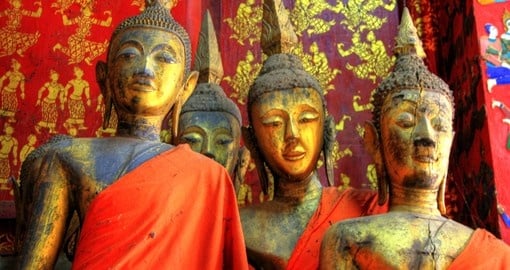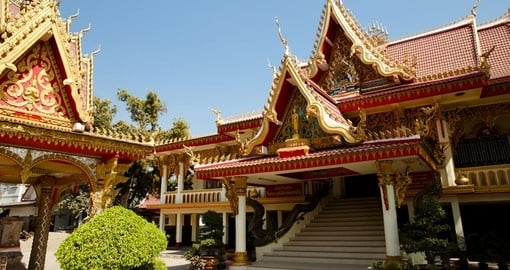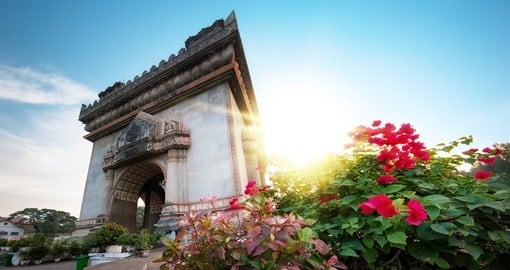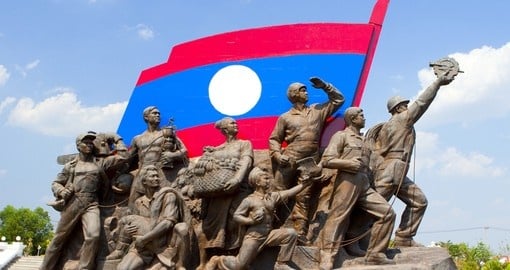Laos History
Human history is believed to have begun in Laos as early as ten thousand years ago. Archaeological digs in Huaphan and Luang Prabang have found stone tools and skulls and therefore confirm this belief. During the 4th to 8th centuries, rural settlements and communities known as “muang” or townships began to form along the Mekong River. These townships were most likely populated by people from the Ti Tribe that were driven southward from Yunnan in southern China.
By the mid-13th century, the Mongol invasion of China at the hands of Kublai Khan increased the south and western migration of Austro-Thai people into Laos. The middle of the 14th century saw King Fa Ngoum establish the Lan Xang Kingdom and based the capital in modern-day Luang Prabang. King Fa Ngoum was a strong warrior and between 1353-71, he managed to invade and conquer territories that included not only present-day Laos but also parts of northern and eastern Thailand.
The 16th century saw the capital of Laos moved to Vientiane during the reign of King Setthathirath as well as a Burmese occupation that lasted for seven years. Towards the end of the century, there were two kingdoms in Laos, one in Luang Praband and one in Vieng Chan. However, they were united under King Nokeo Koumane.
Laos entered into its “Golden Age” during the 17th century. Led by King Souliyavongsa, the country, which had been vastly overlooked by much of the world was quickly attracting European interest. The first to arrive were the Dutch and the East India Company. They reported that Laos was a very interesting and religious country and Vientiane was considered the most beautiful city in southeast Asia.
At the start of the 18th century, feudal lords in Laos began to challenge for the throne which led to the division of the country into three kingdoms, one in Luang Prabang, one in Vientiane and one in Champassack in 1713. This internal division meant Laos was susceptible to attacks and invasions. By the end of the century, much of Laos was under Siamese (Thai) control. War broke out in 1820 but only succeeded in all three kingdoms being ceded to the Thais. French colonial interest in Indochina peaked during this time and they came to Laos’ rescue. In 1893, the Thais relinquished control to France, making Laos a protectorate but with autonomy in local matters. Laos remained a French protectorate until the Second World War.
With France preoccupied fighting the Second World War at home, it was easy for Japan to occupy Laos. During the occupation, resistance groups formed to prevent the French from returning after the war. These groups were able to seize power in Vientiane, Savannakhet and several other towns and established a provisional government and deposed the king. However, after the war, the French began reoccupation and Laos was not granted independence until 1953. Despite this milestone, internal feuding between neutralists and communists continued for years.
When the US bombed North Vietnamese troops on the Ho Chi Minh Trail in eastern Laos in 1964, the conflict between royalist Vientiane government supporters and the communist Pathet Lao population who supported Northern Vietnamese troops began. A coalition government was formed but after the fall of Saigon in 1975, most royalists fled to France. The Laos People’s Democratic Republic was established in December 1975 with the Pathet Lao taking control.
The 1980s saw Laos remain friendly with Vietnamese Communists, however, a move towards a market economy resulted in a relaxation of restrictions as well as a boost in tourism. During the 1990s, Laos began to free itself from the “Vietnamese yolk” and opened lines of communication with the rest of Southeast Asia. The late 1990s witnessed a landmark event when Laos joined ASEAN in July 1997. Laos now has a closer relationship with Thailand and increased tourism has done much to boost the economy.
Laos Travel Information
At Goway we believe that a well-informed traveller is a safer traveller. With this in mind, we have compiled an easy-to-navigate travel information section dedicated to Laos.
Learn about the history and culture of Laos, the must-try food and drink, and what to pack in your suitcase. Read about Laos's nature and wildlife, weather and geography, along with 'Country Quickfacts' compiled by our travel experts. Our globetrotting tips, as well as our visa and health information, will help ensure you're properly prepared for a safe and enjoyable trip. The only way you could possibly learn more is by embarking on your journey and discovering Laos for yourself. Start exploring… book one of our Laos tours today!
Extend Your Trip
After your Laos tour, consider taking the time to visit other destinations. Goway offers exciting China vacation packages, India tours and Thailand vacation packages plus a comprehensive selection of vacation packages in many other Asian countries.
Book your Laos tour with Goway!
 ASIA by Goway is an exclusive division that specializes in planning and organizing Laos tours, vacations and experiences. Choose from a simple city stopover, a stay of distinction, an independent travel module, and much more. We want to be your first choice when next you go globetrotting to Laos.
ASIA by Goway is an exclusive division that specializes in planning and organizing Laos tours, vacations and experiences. Choose from a simple city stopover, a stay of distinction, an independent travel module, and much more. We want to be your first choice when next you go globetrotting to Laos.
Get a Trip Quote Order a Brochure




















